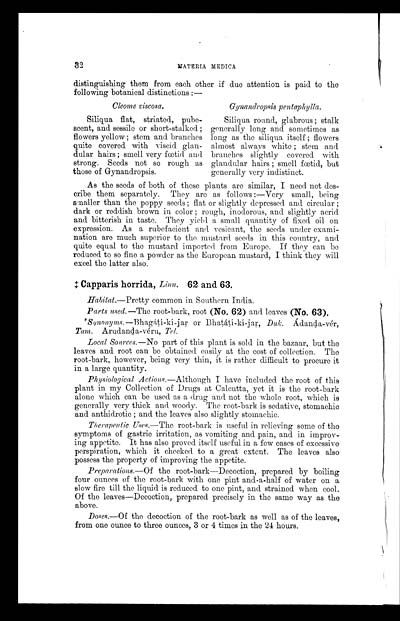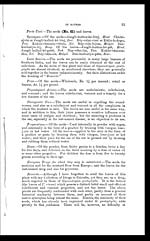Medicine - Drugs > Materia medica of Madras volume I > Vegetable kingdom
(48) Page 32
Download files
Individual page:
Thumbnail gallery: Grid view | List view

32
MATERIA MEDICA
distinguishing them from each other if due attention is paid to the
following botanical distinctions: —
| Cleome viscosa. | Gynandropsis pentaphylla. |
| Siliqua flat, striated, pube- scent, and sessile or short-stalked; flowers yellow; stem and branches quite covered with viscid glan- dular hairs; smell very fœtid and strong. Seeds not so rough as those of Gynandropsis. |
Siliqua round, glabrous; stalk generally long and sometimes as long as the siliqua itself; flowers almost always white; stem and branches slightly covered with glandular hairs; smell fœtid, but generally very indistinct. |
As the seeds of both of these plants are similar, I need not des-
cribe them separately. They are as follows: —Very small, being
smaller than the poppy seeds; flat or slightly depressed and circular;
dark or reddish brown in color; rough, inodorous, and slightly acrid
and bitterish in taste. They yield a small quantity of fixed oil on
expression. As a rubefacient and vesicant, the seeds under exami-
nation are much superior to the mustard seeds in this country, and
quite equal to the mustard imported from Europe. If they can be
reduced to so fine a powder as the European mustard, I think they will
excel the latter also.
‡ Capparis horrida, Linn. 62 and 63.
Habitat.—Pretty common in Southern India.
Parts used.—The root-bark, root (No. 62) and leaves (No. 63).
Synonyms.—Bhagátí-kí-jar or Bhatáti-kí-jar, Duk. Ádanda-vér,
Tam. Arudanda-véru, Tel.
Local Sources.—No part of this plant is sold in the bazaar, but the
leaves and root can be obtained easily at the cost of collection. The
root-bark, however, being very thin, it is rather difficult to procure it
in a large quantity.
Physiological Actions.—Although I have included the root of this
plant in my Collection of Drugs at Calcutta, yet it is the root-bark
alone which can be used as a drug and not the whole root, which is
generally very thick and woody. The root-bark is sedative, stomachic
and anthidrotic; and the leaves also slightly stomachic.
Therapeutic Uses.—The root-bark is useful in relieving some of the
symptoms of gastric irritation, as vomiting and pain, and in improv-
ing appetite. It has also proved itself useful in a few cases of excessive
perspiration, which it checked to a great extent. The leaves also
possess the property of improving the appetite.
Preparations.—Of the root-bark—Decoction, prepared by boiling
four ounces of the root-bark with one pint and-a-half of water on a
slow fire till the liquid is reduced to one pint, and strained when cool.
Of the leaves—Decoction, prepared precisely in the same way as the
above.
Doses.—Of the decoction of the root-bark as well as of the leaves,
from one ounce to three ounces, 3 or 4 times in the 24 hours.
Set display mode to: Large image | Zoom image | Transcription
Images and transcriptions on this page, including medium image downloads, may be used under the Creative Commons Attribution 4.0 International Licence unless otherwise stated. ![]()
| India Papers > Medicine - Drugs > Materia medica of Madras volume I > Vegetable kingdom > (48) Page 32 |
|---|
| Permanent URL | https://digital.nls.uk/74907657 |
|---|




